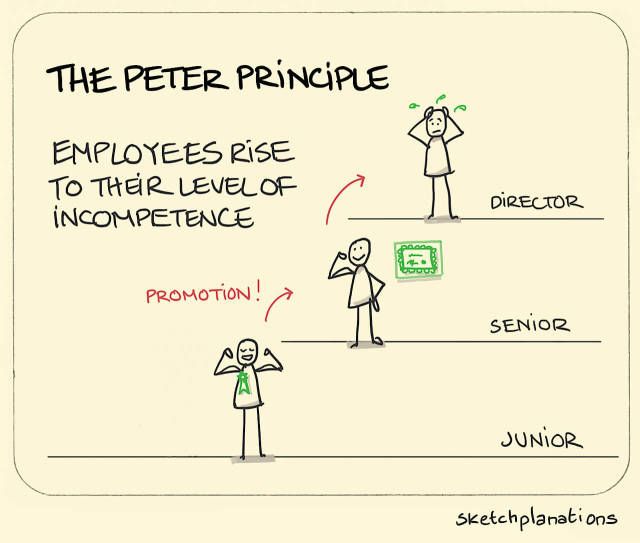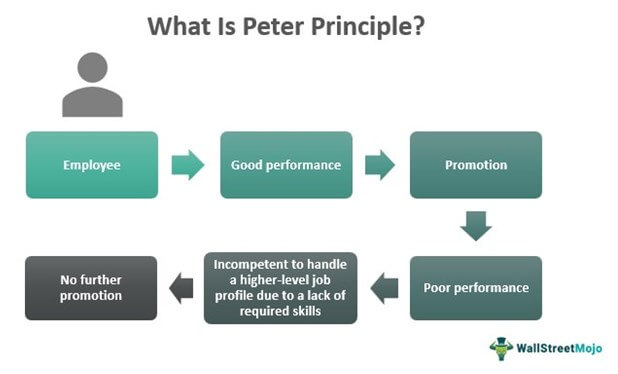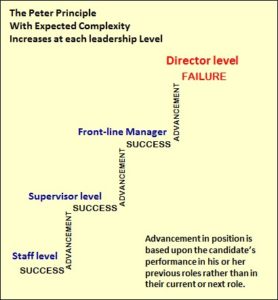Understanding the Peter Principle

The Peter Principle refers to the phenomenon where individuals are promoted to positions of incompetence based on their performance in their current roles. It suggests that employees will continue to be promoted until they reach a position where they can no longer perform effectively. Understanding the Peter Principle is crucial for organizations to avoid the negative consequences of promoting solely based on performance. By recognizing the limitations of promoting based on performance, companies can shift their focus to promoting based on potential and ensure that employees are placed in positions that align with their skills and abilities.
1 What is the Peter Principle?
What is the Peter Principle? The Peter Principle refers to the phenomenon where individuals are promoted to positions of incompetence based on their performance in their current roles. It suggests that employees will continue to be promoted until they reach a position where they can no longer perform effectively. This can negatively affect organizations, as promoting incompetent individuals can lead to decreased productivity, employee dissatisfaction, and overall organizational inefficiency. To avoid these issues, it is crucial for companies to recognize the limitations of promoting based on performance and instead focus on promoting based on potential.
2 Origins and Concept of the Peter Principle

Laurence J. Peter introduced the Peter Principle in his 1969 book, “The Peter Principle: Why Things Always Go Wrong.” It is based on the observation that individuals tend to be promoted to positions of incompetence. The concept suggests that people are promoted based on their performance in their current roles rather than their ability to excel in the new position. As a result, organizations may unintentionally place individuals in positions where they cannot perform effectively. This can lead to decreased productivity, frustration, and overall inefficiency within the organization.
The Impact of Promoting Based on Performance
Promoting based on performance can have several negative impacts on an organization. Firstly, it can lead to individuals being placed in positions lacking the necessary skills, resulting in decreased productivity and inefficiency. Secondly, it can create frustration and dissatisfaction among promoted employees beyond their capabilities. Lastly, promoting based solely on performance can overlook individuals with potential and hinder the growth and development of the organization. It is important for organizations to consider potential and other relevant factors when making promotion decisions.
1 Effects of promoting based on performance
Promoting based on performance can have negative effects on an organization. It may result in individuals being placed in positions lacking the necessary skills, leading to decreased productivity and inefficiency. Additionally, it can create frustration and dissatisfaction among promoted employees beyond their capabilities. Lastly, promoting solely based on performance can overlook individuals with potential, hindering the growth and development of the organization. Organizations should consider potential and other relevant factors when making promotion decisions.
Common pitfalls and challenges
When promoting based on performance, organizations may encounter common pitfalls and challenges. For example, there is a risk of promoting individuals who excel in their current role but struggle to adapt to the new responsibilities. This can result in decreased productivity and increased dissatisfaction. Additionally, promotion solely based on performance can create a competitive and unhealthy work environment where employees prioritize their own success over collaboration. Organizations need to carefully consider these challenges and implement strategies to overcome them when promoting based on performance.
Shifting Focus to Potential
Shifting focus to potential is crucial when promoting employees, as it enables organizations to identify and develop individuals who have the ability to succeed in higher-level positions. Organizations should implement strategies such as competency assessments, talent development programs, and succession planning to do this effectively. Additionally, providing employees with continuous learning and growth opportunities can help uncover their hidden potential and ensure a pipeline of future leaders. Organizations can build a strong and capable workforce for long-term success by prioritising potential over sole performance.
Importance of promoting based on potential
By promoting based on potential, organizations can tap into their employees’ untapped capabilities and skills, allowing them to grow and contribute to the organization in new and meaningful ways. This approach allows for a more diverse and inclusive workforce, as individuals who may not have had the opportunity to showcase their potential based on past performance can now be considered for higher-level positions. Additionally, promoting based on potential encourages continuous learning and development, creating a culture of growth within the organization.

Strategies for identifying and nurturing potential
- Talent assessments: Implement comprehensive talent assessments that evaluate current performance and potential for growth and development. These assessments can include psychometric tests, performance evaluations, and behavior-based interviews to gauge an individual’s strengths and areas for improvement.
- Development programs: Provide targeted development programs and resources to individuals with high potential. These programs can include mentoring, coaching, training, and special assignments that challenge and stretch employees, helping them develop the skills and knowledge needed for future roles.
Remember, identifying and nurturing potential is crucial for creating a pipeline of capable leaders within the organization. By implementing these strategies, organizations can ensure they cultivate talent and promote based on future potential rather than past performance alone.
Implementing a Potential-Based Promotion Strategy
To effectively implement a potential-based promotion strategy within your organization, consider the following best practices:
- Conduct comprehensive talent assessments that evaluate current performance and future potential for growth and development.
- Provide targeted development programs and resources to individuals identified as having high potential. This may include mentoring, coaching, training, and special assignments.
- Foster a culture that values and rewards potential, emphasizing the importance of long-term growth and development over short-term performance.
- Communicate the criteria and process for promotion based on potential clearly to all employees, ensuring transparency and fairness throughout the organization.
- Continuously monitor and evaluate the progress and success of the potential-based promotion strategy, making necessary adjustments and improvements along the way.
By implementing these strategies, you can create a talent pipeline of capable leaders and ensure that promotions are based on future potential rather than just past performance.
Best practices for promoting based on potential
Conduct comprehensive talent assessments that evaluate current performance and future potential for growth and development. Provide targeted development programs and resources to individuals with high potential, such as mentoring, coaching, training, and special assignments. Foster a culture that values and rewards potential, emphasizing the importance of long-term growth and development. Communicate the criteria and process for promotion based on potential clearly to all employees, ensuring transparency and fairness throughout the organization. Continuously monitor and evaluate the progress and success of the potential-based promotion strategy, making necessary adjustments and improvements along the way.
Overcoming resistance and organizational barriers
To overcome resistance and organizational barriers when implementing a potential-based promotion strategy, it is important to engage with key stakeholders and communicate the rationale and benefits of this approach. Address any concerns or fears that may arise, emphasizing the fairness and transparency of the process. Provide training and support to managers to ensure they have the skills and tools to assess and develop potential effectively. Foster a culture that rewards growth and development, encouraging employees to embrace new opportunities and challenges. Continuously monitor and evaluate the strategy’s success, making adjustments as needed to ensure its effectiveness.
Case Studies and Examples

Let’s examine some real-world case studies to reinforce the benefits of promoting based on potential. Company X, for example, implemented a potential-based promotion strategy and saw a significant increase in employee satisfaction and retention. They used assessments, such as performance reviews and behavioral interviews, to identify employees with high potential. They successfully groomed these individuals for higher-level positions by providing targeted training and development opportunities. Another example is Company Y, which focused on cross-functional experiences to broaden employees’ skill sets and identify those with untapped potential. These case studies demonstrate the effectiveness of promoting based on potential and provide valuable insights for organizations considering this approach.
Successful implementation of potential-based promotions
Company X is a standout example of a successful implementation of potential-based promotions. By utilizing assessments like performance reviews and behavioral interviews, they could identify employees with high potential. These individuals were then provided targeted training and development opportunities, preparing them for higher-level positions. The result was a significant increase in employee satisfaction and retention. Company X’s approach highlights the effectiveness of promoting based on potential and offers valuable insights for other organizations looking to adopt this strategy.
Lessons learned from real-world scenarios

- Lesson 1: Properly assess employee potential – Real-world examples have taught us the importance of thorough evaluation when identifying employees with high potential. This includes utilizing various assessment tools, such as performance reviews and behavioral interviews, to gather comprehensive insights.
- Lesson 2: Provide targeted development opportunities – Successful businesses have realized the value of providing targeted training and development opportunities to employees with high potential. This prepares them for higher-level positions and increases their motivation and engagement. By investing in their growth, organizations can foster a pipeline of talented individuals ready to take on new challenges.
Conclusion and Recommendations
After analyzing the concept of the Peter Principle and the impact of promoting based on performance, it is clear that organizations should shift their focus to promoting based on potential. Businesses can foster a pipeline of talented individuals by properly assessing employee potential and providing targeted development opportunities. Implementing a potential-based promotion strategy requires best practices and overcoming resistance. Real-world examples have taught us the importance of thorough evaluation and investing in employee growth. By following these lessons, organizations can effectively promote based on potential and drive success within their workforce.
Key takeaways on promoting based on potential
Key takeaways on promoting based on potential:
- Assess potential: It is crucial to evaluate employees based on their potential to succeed in higher-level roles, rather than just their current performance.
- Invest in development: Providing targeted development opportunities can help employees reach their full potential and prepare them for future promotions.
- Offer guidance and mentorship: Effective guidance and mentorship programs can nurture talent and help individuals develop the skills needed for advancement.
- Create a culture of continuous learning: Encouraging a growth mindset and supporting ongoing learning and skill development can help employees reach their potential and adapt to changing business needs.
- Communicate transparently: Clear communication about the promotion process and criteria can help employees understand what is expected of them and how they can work towards advancement.
- Consider potential in performance reviews: Incorporate assessments of potential into performance reviews to ensure a well-rounded evaluation of employees’ capabilities.
By following these key takeaways, organizations can effectively identify and promote individuals based on their potential, leading to a stronger and more successful workforce.
Future trends in talent management and promotion strategies
As the world of work continues to evolve, so too must talent management and promotion strategies. Two future trends that are expected to shape these areas include:
- Emphasis on Soft Skills: With automation and artificial intelligence becoming more prevalent, the demand for human-centric skills such as creativity, emotional intelligence, and adaptability will increase. Organizations must focus on identifying and developing these skills in their employees to ensure they can thrive in the future workplace.
- Data-Driven Decision-Making: Data and analytics in talent management and promotion decisions will become more widespread. HR professionals will rely on data to assess performance, potential, and engagement levels, enabling more objective and effective decision-making processes.
By staying ahead of these trends, organizations can better align their talent management and promotion strategies with the changing needs of the workforce and position themselves for success in the future.




